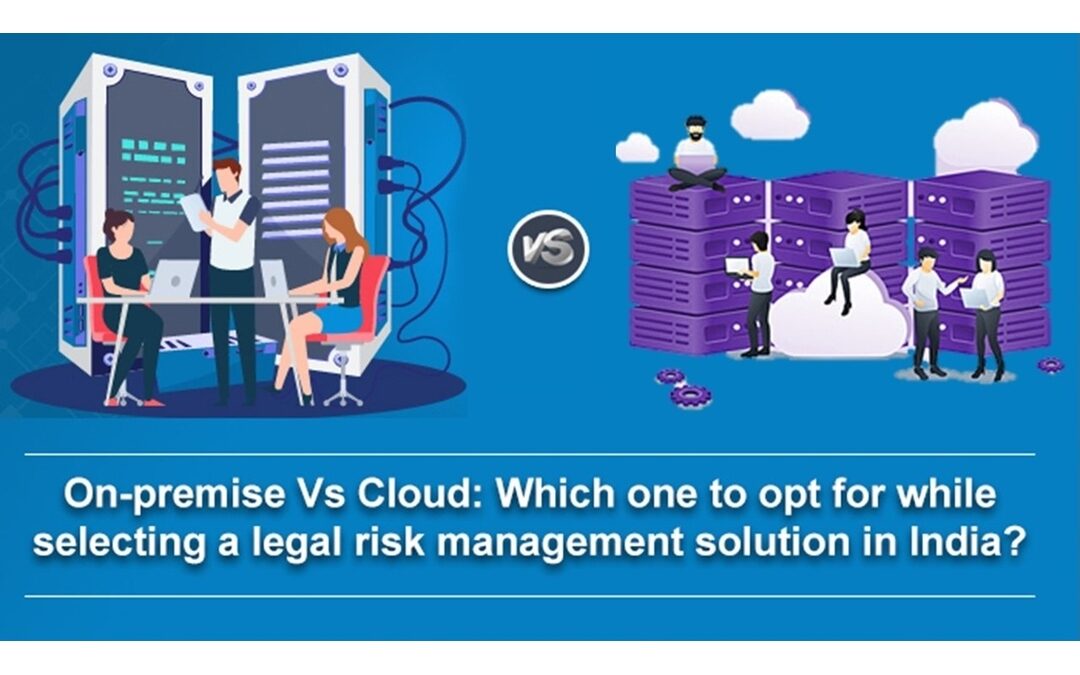Is it time to get our head in the clouds or place our feet firmly on the ground?
Most companies have drifted towards managing their legal risks via various risk management software solutions, it is therefore important to determine which type of deployment to opt for, while selecting your solution.
When it comes to a choice between on-premise or cloud software deployment, it is one of the toughest decisions for an organization to make, as one of them provides a direct control over the infrastructure, while the other is the more economical and feasible option.
What is cloud based deployment and how does it differ from on-premise?
The basic difference between an on-premise and cloud is, on-premise is when the software is installed on-site, that is on the company’s servers or infrastructure owned by them.
On the other hand, there are cloud-based software, wherein the software is hosted on a third-party cloud/data center and is provided on demand to the user via browser or application anywhere they would want, this is more advantageous for companies with multiple locations as well as it is the more cost friendly option.
There are broadly three cloud deployment models:
– Public
– Private
– Hybrid.
Each deployment model is dependent on the infrastructure of the environment it is located in. We will come out with another follow-up blog on this topic shortly.
Now, let us take a closer look at the advantages and obstacles of each deployment method, to better understand which one to opt for.
Advantages and obstacles
Maintenance and control:
For on-premise:
The client is responsible for maintenance of the software as the deployment is done on their internal infrastructure, which also means that they have complete and exclusive control over their data within the software which increases their privacy, these are primarily the two reasons why big organisations tend to opt for on-premise deployment. However, on the flipside to this, a lot of time-consuming handholding is required from both the internal and external teams for an on-premise deployment. It is also not the most efficient model when there is a requirement of increasing the scope due to upscaling more branches and more users.
An example to understand the drawback would be that for an on-premise deployed compliance management software, the regulatory updates take place only through patch updates and consequently, the end users are deprived of real-time updates as there is a considerable delay in receiving the updates, which is an integral part of any good compliance management solution.
For cloud:
The application provider is in charge for the maintenance of the software on their server, which can be accessed by the user at any given time and the ownership is partly shared with the service provider in order for them to be able to maintain and update the relevant systems that help to run the application in the cloud.
Security:
For on premise:
Many people believe that the security risk is less because it is on a closed off private server, however getting all the various security measures in place and ensuring the upkeep of those measures can be a costly and time-consuming activity.
For on cloud:
Even though the data is being stored on a third-party server which may lead to a belief that the possibility of a breach increases, it is not the case, as software service providers and third party cloud service providers have very powerful security systems in place, generally a costlier security than that which can be afforded by individual organisations, this is to ensure there is no possibility of a breach and they also have sufficient back up servers in place for protection from any such breach or data loss.
The service providers are aware that they have to provide the upmost security otherwise their solution will not fair in the market.
Cost:
For on premise:
This factor is quite often the tipping cause for many enterprises to choose cloud, as on-premise deployment is usually a costly affair as it includes not only a lot of effort for the deployment but is conjoined with a hefty upfront payment followed by the added fixed cost of maintenance and operations on an ongoing basis to be incurred by the organisation themselves, as well as also numerous variable costs which are added for upgradation, system failures, upscaling and so.
For cloud:
It is definitely the more affordable of the two options, as instead of an upfront hefty cost it is usually on a subscription basis, further the maintenance and operations are managed by the service provider and these costs are part of the subscription fees. This drastically reduces the overall cost for the organisation.
Accessibility:
For on premise:
As the software is installed on the client’s in-house servers, remote access for technical and customer support by the software service provider becomes a hinderance at times, it is possible for users to access the software via an application on personal devices when they are away but that may require assistance from a concerned team in house which again increases the required security measures, efforts which adds to the cost as well.
For cloud:
All you require is a stable internet connection and you can easily access your secure portal for the software and access it remotely from anywhere. Therefore, ease of secured access and flexibility is a big plus point for cloud systems.
When we compare the various advantages and disadvantages of both the methods, it is clear that there is no one obvious winner. Depending on your organisation and its requirements either could be more beneficial to you.
Having said so, earlier most people preferred on-premise deployment even though it was costlier as there were less advancements in cloud technology and security but in recent times with information security certifications and compliances in place, cloud services by service providers have developed into a much more refined, convenient, and secure method of storage, data transfer and software hosting.
The future is ‘Cloudy’
In the past year due to the COVID-19 pandemic, many companies and organisations have opted to migrate from on-premise to cloud for their computing and software requirements as more remote work was required than working in the office premises, as work from home became the new norm.
Cloud deployment allows the employees to access the software from anywhere with just their login credentials, it reduces the operational cost without compromising the business continuity process.
This shift from on-premise to cloud has been enlightening for many to understand the nuances of the distinctions between the two methods which helps to highlight the preferred option.
Ease of access, flexible, cost effective, high security, no added maintenance or upkeep requirement, on time upgrades and updates, quick deployment, and ease of upscaling are associated to only one of these deployment methods.
Analyse your organisation’s requirements, future prospects and budgetary restrictions before taking an ultimate decision, because as far as software technology is concerned, the sky is the limit, and it is full of “clouds”.
Hopefully, you will find this blog useful while selecting an ideal legal risk management solution in India. In case you want to know more, you can check our latest blogs Advantages of deploying a Litigation Management Solution, Benefits of using a compliance management tool and Key aspects to consider before procuring a contract management solution.
Written by: Viraj Ranjan Singh
Edited by: Koushik Sinha
Additional Inputs: Sohom Roy, Saikat Mondal
Disclaimer
All material included in this blog is for informational purposes only and does not purport to be or constitute legal or other advice. This blog should not be used as a substitute for specific legal advice. Professional legal advice should be obtained before taking or refraining from an action as a result of the contents of this blog. We exclude any liability (including without limitation that for negligence or for any damages of any kind) for the content of this blog. The views and opinions expressed in this blog are those of the author/(s) alone and do not necessarily reflect the official position of Lexplosion Solutions. We make no representations, warranties or undertakings about any of the information, content or materials provided in this blog (including, without limitation, any as to quality, accuracy, completeness or reliability). All the contents of this blog, including the design, text, graphics, their selection and arrangement are the intellectual property of Lexplosion Solutions Private Limited and/or its licensors.
ALL RIGHTS RESERVED, and all moral rights are asserted and reserved.





